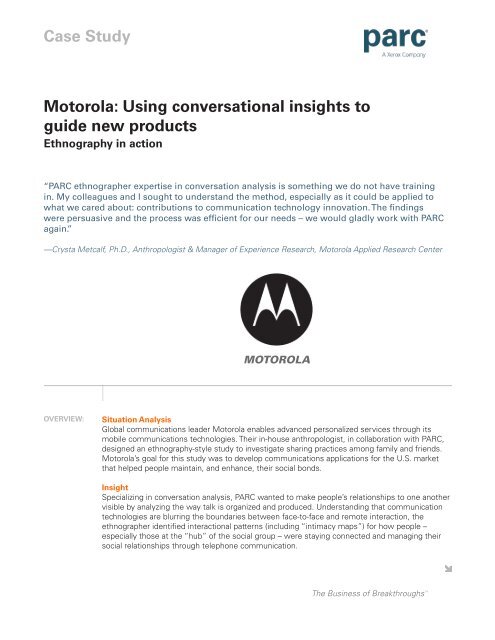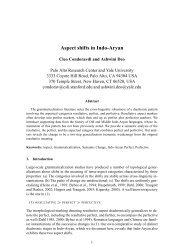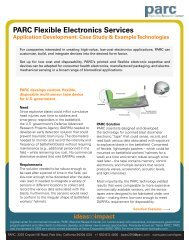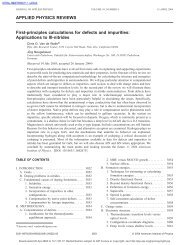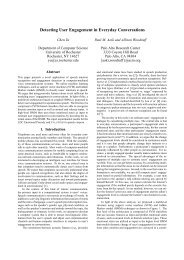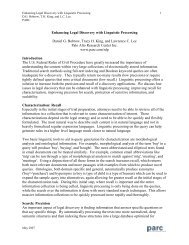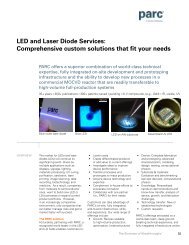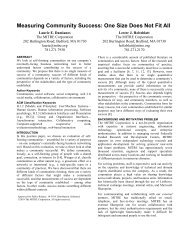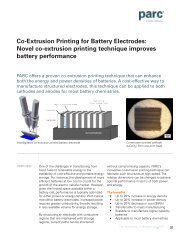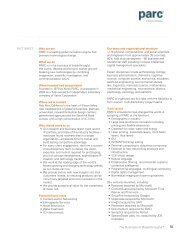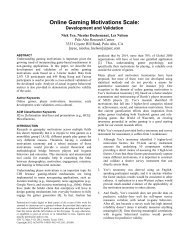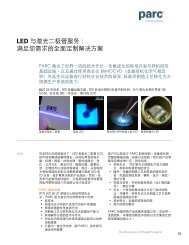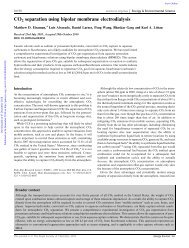Case Study Motorola: Using conversational insights to guide ... - Parc
Case Study Motorola: Using conversational insights to guide ... - Parc
Case Study Motorola: Using conversational insights to guide ... - Parc
Create successful ePaper yourself
Turn your PDF publications into a flip-book with our unique Google optimized e-Paper software.
<strong>Case</strong> <strong>Study</strong><br />
<strong>Mo<strong>to</strong>rola</strong>: <strong>Using</strong> <strong>conversational</strong> <strong>insights</strong> <strong>to</strong><br />
<strong>guide</strong> new products<br />
Ethnography in action<br />
“PARC ethnographer expertise in conversation analysis is something we do not have training<br />
in. My colleagues and I sought <strong>to</strong> understand the method, especially as it could be applied <strong>to</strong><br />
what we cared about: contributions <strong>to</strong> communication technology innovation. The findings<br />
were persuasive and the process was efficient for our needs – we would gladly work with PARC<br />
again.”<br />
—Crysta Metcalf, Ph.D., Anthropologist & Manager of Experience Research, <strong>Mo<strong>to</strong>rola</strong> Applied Research Center<br />
MOTOROLA<br />
OVERVIEW:<br />
Situation Analysis<br />
Global communications leader <strong>Mo<strong>to</strong>rola</strong> enables advanced personalized services through its<br />
mobile communications technologies. Their in-house anthropologist, in collaboration with PARC,<br />
designed an ethnography-style study <strong>to</strong> investigate sharing practices among family and friends.<br />
<strong>Mo<strong>to</strong>rola</strong>’s goal for this study was <strong>to</strong> develop communications applications for the U.S. market<br />
that helped people maintain, and enhance, their social bonds.<br />
Insight<br />
Specializing in conversation analysis, PARC wanted <strong>to</strong> make people’s relationships <strong>to</strong> one another<br />
visible by analyzing the way talk is organized and produced. Understanding that communication<br />
technologies are blurring the boundaries between face-<strong>to</strong>-face and remote interaction, the<br />
ethnographer identified interactional patterns (including “intimacy maps”) for how people –<br />
especially those at the “hub” of the social group – were staying connected and managing their<br />
social relationships through telephone communication.
Process/Methods<br />
<strong>Using</strong> a combination of observation, pho<strong>to</strong> and video diaries, in-depth semi-structured interviews,<br />
and recorded mobile phone calls over 3 weeks, the <strong>Mo<strong>to</strong>rola</strong> and PARC team gathered data<br />
among 5 social groups of varied demographics and geographic locations. The team applied<br />
“grounded theory affinity analysis” <strong>to</strong> understand social network maintenance patterns such as:<br />
what kinds of information, experiences, and content are shared; processes of sharing; and how<br />
contexts affect sharing.<br />
PARC also conducted conversation analyses across all the recorded phone calls, honing in on<br />
openings and turns-at-talk. For example, the ethnographer identified <strong>to</strong>ne and singsong voice<br />
differences in more familiar relationships as opposed <strong>to</strong> the qualifying conversation tactics (“I<br />
know you must be sick of hearing from me, but…”) used with less familiar acquaintances.<br />
Results<br />
If technology could identify who people were <strong>to</strong> each other – going beyond mere quantitative<br />
data and mechanics of communications – then one could better tailor communication services <strong>to</strong><br />
users. As a result of their study, <strong>Mo<strong>to</strong>rola</strong>’s team identified a number of opportunities that shifted<br />
commonly practiced engineering principles <strong>to</strong> human-centered design. These included moving<br />
from: designing for the sender <strong>to</strong> designing for the receiver; designing for the mechanics <strong>to</strong><br />
designing for the message; and designing for sending facts <strong>to</strong> designing for sharing a s<strong>to</strong>ry.<br />
More Information<br />
Business Development<br />
engage@parc.com<br />
A global center for commercial innovation, PARC (Palo Al<strong>to</strong> Research Center, Inc.) works closely<br />
with enterprises, entrepreneurs, government program partners and other clients <strong>to</strong> discover,<br />
develop, and deliver new business opportunities. Previously known as “Xerox PARC,” PARC<br />
was incorporated in 2002 as a wholly owned subsidiary of Xerox Corporation (NYSE: XRX).<br />
PARC, 3333 Coyote Hill Road, Palo Al<strong>to</strong>, California 94304 USA +1 650 812 4000 | engage@parc.com | www.parc.com<br />
CS.MOTOROLA.1000081810


